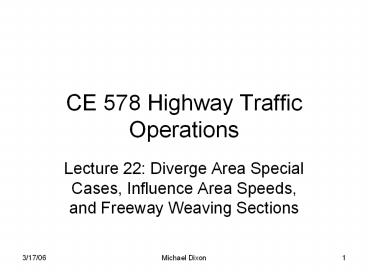CE 578 Highway Traffic Operations - PowerPoint PPT Presentation
1 / 20
Title:
CE 578 Highway Traffic Operations
Description:
CE 578 Highway Traffic Operations Lecture 22: Diverge Area Special Cases, Influence Area Speeds, and Freeway Weaving Sections Objectives Diverge area special cases ... – PowerPoint PPT presentation
Number of Views:83
Avg rating:3.0/5.0
Title: CE 578 Highway Traffic Operations
1
CE 578 Highway Traffic Operations
- Lecture 22 Diverge Area Special Cases, Influence
Area Speeds, and Freeway Weaving Sections
2
Objectives
- Diverge area special cases
- Influence area speeds
- Basic process of weaving section analysis
- Important variables
- Limitations of methodology
3
Diverge Area Special Cases
- Two-lane off-ramps
- Lane drops
- Major diverge areas
- Off-ramps on ten-lane freeways
- Left-hand off-ramps
4
Two-Lane Off-Ramps
5
Two-Lane Off-Ramps (cont.)
- four-lanes PFD 1.00
- six-lanes PFD 0.45
- eight-lanes PFD 0.26
- for calculating DR, LDeff 2LD1 LD2
6
Lane Drops
- Single lane off-ramp with lane drop
ramp-roadway capacity governs - Two lane off-ramp with lane drop see major
diverge segment procedure
7
Major Diverge Area
Analyze each leg as a basic section to determine
their respective capacities and compare to demand
volumes.
8
Off-Ramp on Ten-Lane Freeways
Similar to the on-ramp procedure, but with
different values for the volumes in lane 5 (v5).
9
Left-Hand Off-Ramps
- Same as for On-Ramps except
- Conversion from v12 to v23 or v34
- Six-lane freeway 1.05
- Eight-lane freeway 1.10
10
Influence Area Speeds
- Read pages 25-18 and 25-19
11
Weaving Section Issues
- Diverse traffic streams
- Differences in lane utilization
- Ease of lane change
- Predicting speeds
- Predicting density
12
Basic Process
- Adjust the volume
- Predict the space mean
- Check for constraints on lane changing
- Reassess the space mean speed
- Compute the average space mean speed
- Compute the density
- Determine the LOS
- Determine the weaving capacity
13
Basic Process (cont.)
14
Important Weaving Section Variables
- Demand volumes
- Weaving section length
- Number of lanes
- Weaving section configuration
- Terrain type
- Free-flow speed
15
Demand Volumes, Terrain Type, and Free-Flow Speed
- Adjusted volume See basic segment methodology
- Free-flow speed See basic segment methodology
16
Weaving Section Length
- Less than 2500 ft
- Measure from entrance gore to exit gore
17
Number of Lanes and Weaving Section Configuration
- N?Total lanes in weaving section
- Nw?lanes needed for weaving equilibrium
- Nw(max)?maximum lanes available for weaving
vehicles
18
Number of Lanes and Weaving Section Configuration
19
Number of Lanes and Weaving Section Configuration
20
Limitations
- Ramp metering
- Oversaturated conditions
- Effects of speed limits
- Collector distributor roadways
- Urban streets
- Known weaving volumes































